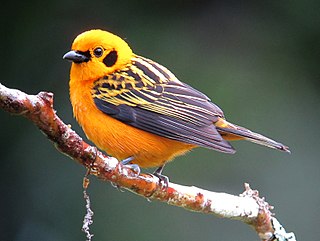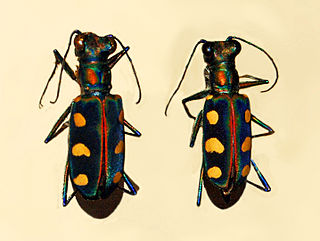
The golden tanager is a species of bird in the family Thraupidae. It is widespread and often common in highland forests of the Andes and Venezuelan Coastal Range in north-western South America.

Auriporia is a small genus of four species of poroid fungi in the family Fomitopsidaceae.
Euxoa aurulenta, the dune cutworm, is a moth of the family Noctuidae. The species was first described by Smith in 1888. It is found in North America from Ontario west to Alberta and Washington, south to Illinois, Nebraska, Colorado and Arizona.

Cicindela aurulenta, common name blue-spotted or golden-spotted tiger beetle, is a beetle of the family Cicindelidae.
Acanthopteroctetes aurulenta is a moth of the family Acanthopteroctetidae. It was described by Donald R. Davis in 1984. It is found in north-western Oregon, central Utah, and Colorado.

Ceragenia is a genus of beetles in the family Cerambycidae, containing the following species:
Serixia is a genus of longhorn beetles of the subfamily Lamiinae, containing the following species:

Buprestis aurulenta, commonly known as the golden jewel beetle or golden buprestid, is a species of beetle in the genus Buprestis.
Serixia buruensis is a species of beetle in the family Cerambycidae. It was described by Stephan von Breuning in 1958.
Serixia cinereotomentosa is a species of beetle in the family Cerambycidae. It was described by Stephan von Breuning in 1958.
Serixia novaebritanniae is a species of beetle in the family Cerambycidae. It was described by Stephan von Breuning in 1958.
Serixia fumosa is a species of beetle in the family Cerambycidae. It was described by Francis Polkinghorne Pascoe in 1867. It is known from Sumatra and Borneo.
Serixia longicornis is a species of beetle in the family Cerambycidae. It was described by Francis Polkinghorne Pascoe in 1858.
Serixia prolata is a species of beetle in the family Cerambycidae. It was described by Francis Polkinghorne Pascoe in 1858.
Serixia sedata is a species of beetle in the family Cerambycidae. It was described by Francis Polkinghorne Pascoe in 1862.
Serixia phaeoptera is a species of beetle in the family Cerambycidae. It was described by Per Olof Christopher Aurivillius in 1927.
Serixia nigroapicalis is a species of long horn beetle in the family Cerambycidae. It was described by Per Olof Christopher Aurivillius in 1927. This species is also part of the genus Serixia, order Coleoptera, class Insecta, phylum Arthropoda, and kingdom Animalia. These beetles can drill into wood and cause damage to live wood.
Caladenia aurulenta is a plant in the orchid family Orchidaceae and is endemic to South Australia. It was first formally described in 2005 by David Jones, who gave it the name Arachnorchis aurulenta and published the description in The Orchadian from a specimen collected in the Gawler Ranges. In 2008, Robert Bates changed the name to Caladenia aurulenta. The specific epithet (aurulenta) is a Latin word meaning "golden", "made of gold" or "ornamented with gold". Caladenia aurulenta occurs in the northern part of the Eyre Peninsula.
Brown's emo skink or golden forest skink is a species of lizard in the family Scincidae. It is found in Papua New Guinea.

Osmia aurulenta is a Palearctic species of mason bee.





